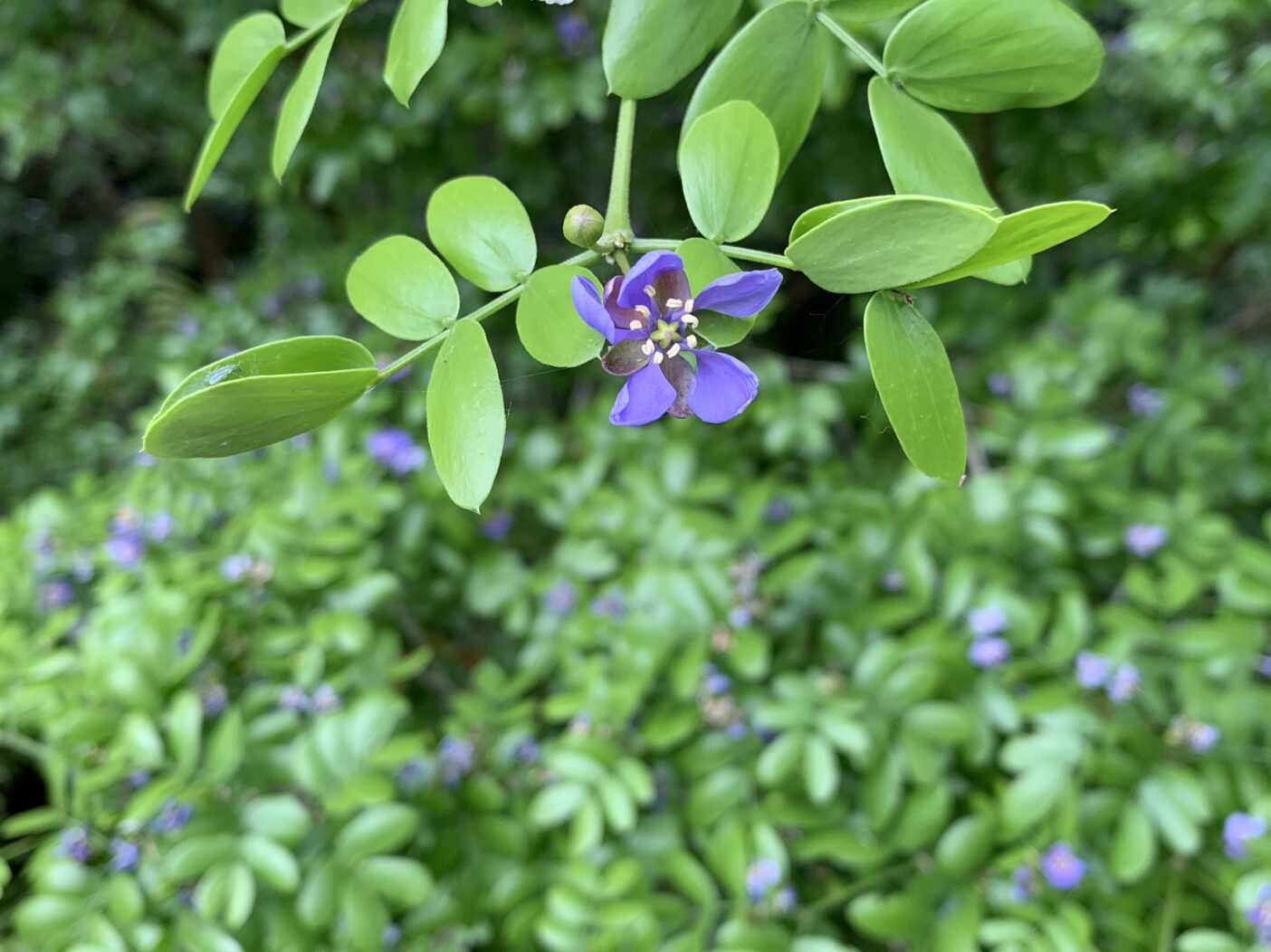
Sometimes, the very name of a plant suggests a good story. In the case of one tree the Garden recently acquired, there are chapters’ worth of tales.
The name: Lignum vitae. It translates as “wood of life” or “tree of life.” A pretty good start, right?
We had two such trees already, located by Kapnick Hall. The third came to us this summer, a gift from Big Cypress National Preserve. The Horticulture Team installed it opposite the two existing ones, for symmetry. Its previous owner is a bit of a legend among Florida naturalists, and we’ll get to that point soon, but first we’ll explore the species itself — Guaiacum (“Lignum vitae,” is its common name, not scientific one).
This hardy, compact hardwood once proliferated the Caribbean, parts of Central and South America, and South Florida. With lovely blue blooms, the lignum vitae is the national flower of Jamaica and the national tree of the Bahamas. But its real prize is the wood.
The timber is oily, easy to manipulate, and dense — so hard and heavy that it sinks. Nevertheless, it became a preferred material in the maritime industry. Shipbuilders carved it into propellers and bearings. In fact, its wood was used to construct the main shaft bearings of the world’s first nuclear submarine, the USS Nautilus. Thomas Edison specified lignum vitae be used in the bearings of his hydroelectric power plant in 1882, a practice followed for generations. The timber also has been turned into furniture, bowling balls, golf club heads, and a host of other items.
The physicians and healers of yesteryear found use for it, too. They’d concoct lignum vitae “teas” or compresses to treat inflammatory ailments such as arthritis, toothache, and tonsillitis. The St. John Historical Society in the U.S. Virgin Islands reports that lignum vitae extract became part of the standard treatment for syphilis in the 1600s and relied on for roughly a century until mercury came into vogue.
Alas, as with so many resources, the lignum vitae’s usefulness led to its over-extraction.
“The wood of Guaiacum is the true lignum-vitae of commerce,” begins a 1921 study of the tree, archived at Yale University. The author warned that the lignum vitae supply in Cuba “is in danger of total exhaustion” and reported that in fiscal years 1914 and 1915, 3,067 tons were exported from one of the island nation’s ports. The overharvesting, in large part, was due to the demands of World War I; the U.S. Navy once sought 427,000 pounds worth of lignum vitae logs. Today, one species, Guaiacum officinale, is listed as “endangered” on the International Union for Conservation of Nature’s Red List. The species we have in the Garden, Guaiacum sanctum, is listed as “near threatened.”
Should you have the patience to grow one (they are extremely slow), you’d be doing a nice service for conservation and have a showpiece for your Southwest Florida yard. That brings us back to our new lignum’s previous owner, a gentleman named Roy McBride, who did just that. Years ago, he planted two of them at his former residence in Big Cypress National Preserve.

McBride is an integral part of bringing the Florida panther back from the brink of extinction. In the early 1970s, the nonprofit World Wildlife Fund asked the Texas animal tracker to come to Florida to determine whether any panthers remained in the wild. McBride found one, a scrawny female, and a few scattered signs of others, according to a Tampa Bay Times article published last summer. McBride tracked the big cats, and state biologists fitted them with radio transmitters for study. The animals were inbred and ill. To save them, biologists proposed breeding them with Texas cougars. They sent McBride back to Texas, where he pursued female cougars while riding a mule that he blindfolded to keep it from spooking, the Times reported. He brought back eight. Five of them successfully bred with male panthers and launched the comeback of our state animal. A new study published last summer deemed the breeding program a success.
Big Cypress National Preserve is getting out of the residential housing business for its staff and collaborators, and its director, who knew about the Garden’s existing lignum vitae, invited us to take the one McBride had planted (the other was lost in a hurricane).

Brian Galligan, the Vice President of Horticulture, says he values the lignum vitae for a number of reasons, starting with its blue flowers — a rarity among flowering trees. He also stresses the importance of choosing trees and shrubs that can flourish in Southwest Florida without excessive water and fertilizer, which can taint our waters and feed harmful algae. The lignum vitae, which favors our high alkaline soils, is one such species.
Beyond the plant’s practicality is a more emotional reason for seeking them out.
“Plants have history and create a sense of place that draws you in to love them, appreciate them, conserve them, and tell their stories,” Galligan says. “By planting them, we don’t have to say, ‘Remember when …’ about the lignum vitae — just like the panther. By conserving them, the stories will keep evolving forever.”
 About the Author
About the Author
Jennifer Reed is the Editorial Director of Naples Botanical Garden and a longtime Southwest Florida journalist.

